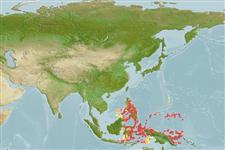Classification / Names
Common names from other countries
Main reference
Size / Weight / Age
Max length : 1.9 cm SL male/unsexed; (Ref. 102609); 1.7 cm SL (female)
Environment
Marine; reef-associated; depth range 5 - 71 m (Ref. 102609)
Climate / Range
Tropical, preferred ?; 20°N - 9°S, 114°E - 154°E
Distribution
Short description
Dorsal
spines
(total): 7;
Dorsal
soft rays
(total): 8-9;
Anal
spines: 1;
Anal
soft rays: 8. This species is distinguished by the following characters: first dorsal fin with a large (slightly greater than pupil diameter in width) round, black, ocellated spot in between spines 1 and 5; a second, much smaller black or dark red spot just posterior to the spine of the second dorsal fin and above the basal stripe; body yellow with a dark purplish or gray head with two distinct red bars across the cheek; without round spots of any colour on the nape, opercle or cheek; upper pectoral fin base with a small dark (preserved) or white (alive) spot; a narrow bony interorbital (<70% pupil diameter); first dorsal fin without elongated spines; pectoral fin rays 15-16, with the middle 4-8 rays branched; fifth pelvic fin ray with a single dichotomous branch; total gill rakers on the first gill arch 16-17 (Ref. 102609).
IUCN Red List Status (Ref. 115185)
Threat to humans
Harmless
Human uses
More information
Common namesSynonymsMetabolismPredatorsEcotoxicologyReproductionMaturitySpawningFecundityEggsEgg development
Age/SizeGrowthLength-weightLength-lengthLength-frequenciesMorphometricsMorphologyLarvaeLarval dynamicsRecruitmentAbundance
ReferencesAquacultureAquaculture profileStrainsGeneticsAllele frequenciesHeritabilityDiseasesProcessingMass conversion
Tools
Special reports
Download XML
Internet sources
Estimates of some properties based on models
Phylogenetic diversity index
PD50 = 0.5000 many relatives (e.g. carps) 0.5 - 2.0 few relatives (e.g. lungfishes)
Trophic Level
0
Resilience
High, minimum population doubling time less than 15 months (Preliminary K or Fecundity.)
Vulnerability
Low vulnerability (10 of 100)
Price category
